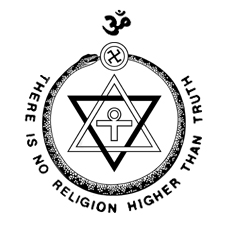Mabel Besant-Scott
| Part of a series on |
| Theosophy |
|---|
 |
Mabel "Mabs" Emily Besant-Scott (née Besant; 28 August 1870 in Leckhampton, Cheltenham – 22 May 1952 in Folkestone, Kent[1][2]) was a Theosophist, Co-Freemason and Rosicrucian.[3]
She was the daughter of the Theosophist, Secularist, and Co-Freemason Annie Besant[4] and her husband Rev. Frank Besant. She had an older brother named Arthur Besant. When her father and mother separated, she was to be under the custody of her mother, but in 1878 her father went to the High Court and won the case for custody. It was not until she was 21 that she returned to her mother.[5]
In 1892 Mabel married a journalist named Ernest Scott at Marylebone, London. They emigrated to Australia[6] where she had a daughter, Muriel and became a Roman Catholic. She returned to England with Muriel in 1909 but Scott did not sue for divorce until 1915.[7] For some time she assisted her mother in both British Co-Masonry and the Theosophical Society Adyar.
After her mother's death, Mabel Besant-Scott briefly became the head of the British Federation of Co-Freemasonry and held the highest thirty third degree in Scottish Rite Freemasonry.[8] In 1933 she visited India where her mother died and met the Avatar Meher Baba, where they discussed her mother resurrecting as a man in India.[9] She wrote several articles for The Adyar Bulletin, a periodical of the Theosophical Society based in Adyar, India.[10] A year later she abruptly resigned from Co-Freemasonry,[3] joining the Rosicrucian Order Crotona Fellowship shortly afterwards and taking with her some of her followers from Co-Masonry. She was one of the most active members of this Rosicrucian theatre near Christchurch, which was led by George Alexander Sullivan.[11]
In The Rebirth of Witchcraft by Doreen Valiente and Witchcraft Today: An Encyclopedia of Wiccan and Neopagan Traditions by James R. Lewis, the authors connect the ceremonies Gerald Gardner devised as being a neighbour to Besant Scott.[12][13]
Besant-Scott's portrait is in the collection of the National Portrait Gallery London.[14]
Notes
[edit]- ^ "SCOTT, Mabel Emily Besant", Wills and Probate 1858 - 1996. Retrieved 2017-07-20
- ^ "BESANT-SCOTT Mabel E", FreeBMD. Retrieved 2017-07-20: Deaths Jun 1952, Folkestone 5b 529
- ^ a b Patricia Della-Piana (2010). Witch Daze. Lulu.com. ISBN 9780557763337. Retrieved 25 June 2020.
- ^ Alexandra Heidle, Joannes Augustinus Maria Snoek (2008). Women's Agency and Rituals in Mixed and Female Masonic Orders. BRILL. ISBN 9789004172395. Retrieved 25 June 2020.
- ^ "Mrs. Besant's husband". The Hindu archives. 30 May 1917. Retrieved 25 June 2020.
- ^ Race Matthews (1993). Australia's First Fabian's:Middle-class Radicals, Labour Activists and the Early Labour movement. CUP Archive. ISBN 9780521441339. Retrieved 25 June 2020.
- ^ Kathleen Fitzpatrick (1988). "Scott, Sir Ernest (1867–1939)". Scott, Sir Ernest (1867 - 1939), Australian Dictionary of Biography. Vol. 11. Melbourne University Press. pp. 544–546. Retrieved 24 June 2014.
- ^ Ben Whitmore (2010). Trials of the Moon: Reopening the Case for Historical Witchcraft. Briar Books. ISBN 9780473174583. Retrieved 25 June 2020.
- ^ "Lord Mehers Online Edition". Retrieved 25 June 2020.
- ^ "The Campbell Theosophical Research Library". Retrieved 25 June 2020.
- ^ Heselton, Philip (2000). Wiccan Roots: Gerald Gardner and the Modern Witchcraft Revival. Chieveley, Berkshire: Capall Bann Publishing. ISBN 1-86163-110-3.
- ^ Doreen Valiente (31 January 2018). The Rebirth of Witchcraft. The Crowood Press. ISBN 9780719826931. Retrieved 25 June 2020.
- ^ James R. Lewis (1999). Witchcraft Today: An Encyclopedia of Wiccan and Neopagan Traditions. Bloomsbury Academic. ISBN 9781576071342. Retrieved 25 June 2020.
- ^ "Mabel Emily Besant-Scott (née Besant)". National Portrait Gallery, London. Retrieved 25 June 2020.
